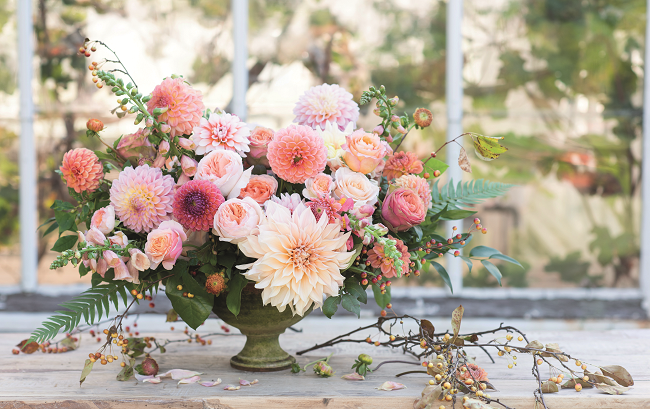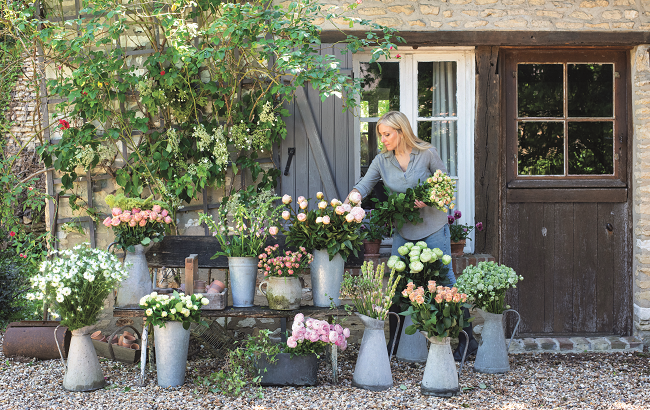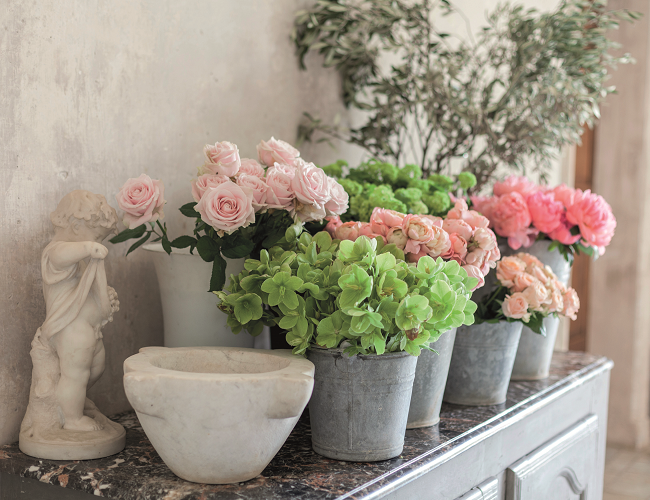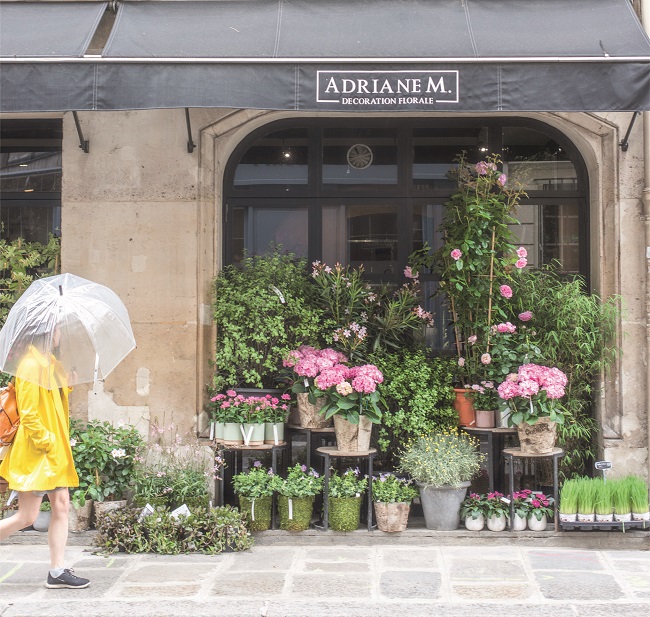Blooming France: the French Art of Flower Arrangement

In her fragrant new book, fleuriste Sandra Sigman explores the French passion and skill for flower arrangement
When it comes to style, the French seem to have been born with it. Whether we’re talking about fashion, home design, or flowers, they exhibit what I can only describe as a sophisticated chicness with a soupçon of casualness and understated grace. Whether you’re in Paris or Provence, you see it everywhere, from the whitewashed country kitchens filled with collected cutting boards to the elegant neck scarves that remain perfectly in place. It’s a unique and utterly irresistible style and one that defines my way of arranging flowers.
The French buy flowers as if they were selecting cheese for a dinner party. I’m not kidding. Instead of rushing into a florist and grabbing a pre-made bunch of flowers (which they’d seldom find), they enter knowing what sort of arrangement they want and where it’s going in their home. Then, they and the florist choose only the finest-quality specimens that are regionally sourced and at their peak to create an arrangement with the perfect size, shape, and colours – just as I do at Les Fleurs with my clients.

© ‘French Blooms’, Sandra Sigman
Seasonal blooms
French florists rarely carry anything out of season, in the same way authentic French restaurants only offer, say, asparagus in spring, chestnuts in the fall, and root vegetables in winter. The wholesale flower stalls of Rungis, where most Parisian florists buy their blooms, support this tradition. For example, in early May, they sell multiple varieties of peonies. When peony season in France ends, approximately nine weeks later, that’s it. When I went shopping for flowers with my mom, she used to buy whatever was available – in season or not. But when I lived in Paris, I saw the glaring difference of peak-season florals versus out-of-season ones. Take tulips, for example, which are at their peak in spring. They have large petal heads, and you’ll find an immense variety. Come summer, the choice of varieties and quality of the heads have begun to fade with the heat. The same holds true for dahlias. The ones that bloom in early summer are less hearty and vibrant than those that flourish in the fall.
When it comes to colour choice, French florists tend to work in specific colour palettes, often all warm- or all cool-coloured blooms. If they mix colours, they tend to choose no more than three; otherwise, the bouquet will look too busy. These similarly hued arrangements, like mine, grace the home with an understated elegance. Regarding the shapes of their arrangements, French florists rarely follow the traditional floral designs taught at most flower arranging schools, like pyramids and balls. Instead, working with specific containers and chosen florals and foliage, the French build each bouquet as if it were a bespoke work of art, adding a sprig of this and that to create an organic, three-dimensional whole. Each arrangement is unique and doesn’t follow a cookie-cutter design because no two flowers are alike.
Read More: The Sunflowers of Provence

© ‘French Blooms’, Sandra Sigman
Unusual varieties
French florists rarely use humdrum flowers, like daisies, pungent lilies, gladioli and baby’s breath. Why? These flowers are grown in abundance and would detract from the overall masterpiece. Instead, they look for unusual seasonal varieties and let each flower’s intrinsic quirks and qualities add structure, rhythm, and texture to the final display, along with complexity and surprise. The French embrace imperfection because it adds individuality. Think about a bouquet of long-stemmed red roses. You’d rarely see that in France. That’s because the commonality of only red roses makes it hard to showcase any design creativity. Instead, the French take a monochromatic approach and combine a few red roses with other similarly-hued florals in, say, burgundy, magenta, and dark pink. The result is more exciting and ultimately stunning.
The French add texture and contrast to their arrangements by choosing flowers and greenery to juxtapose against one another. For example, they might set off smooth elements, like lush, green hosta leaves, with nubby ones, like hyacinth buds or a branch of unripe blackberries. A round sprig of sweet william might pair with a spray of lisianthus. A spiky mass of sea holly might be softened with cashmere- like lamb’s ear.

© ‘French Blooms’, Sandra Sigman
They inject rhythm into their arrangements by placing flowers and foliage in ways that encourage the eye to move all around the finished piece. This means using round and linear flowers and cutting flowers in different lengths to place them high and low in the arrangement. Like the French, I love to create larger pedestal arrangements that have movement via their asymmetric shape. I do this by first arranging the foliage so that one side is higher than the other. Then, I insert the flowers along the same upward curve as the foliage, eventually creating a three-dimensional whole. Repeating colours, textures, and shapes also can add movement, along with adding what I call ‘dancers’. These are blooms, like scabiosa, that have a sort of wavy bounce to them. I like to add a few dancers to the arrangement’s lowest part, so the flowers almost look like they’re falling out of the container.
You also can add liveliness to a bouquet by adding some curling, reaching, and radiating elements to an arrangement, such as corkscrew hazel, sprigs of pussy willow, or bells of Ireland. One of my favourite ways to create a sense of sprightliness to a tablescape is to march small bud-filled cordial glasses or vases down the centre of a dining table interspersed with votives.
Read More: Say It With Flowers

© ‘French Blooms’, Sandra Sigman
Another element of French floral design is to edit the arrangement when it’s nearly complete to give it an airy, romantic looseness. This means pulling out greenery that’s blocking certain flowers and removing specific blooms that are crowding the arrangement. You also want to make sure each bloom is facing out.
The final secret touch is to add a unique visual bonbon, which I sometimes refer to as focal or face flowers. I learned this from my French flower shop mentors. For larger designs, it could be a rare or special bloom, like some gorgeous peonies, to elicit an “Oh, look!” sense of delight.

© ‘French Blooms’, Sandra Sigman
Helpful hints when buying a bouquet à la française:
- Visit your favourite fleuriste on restock day, which is typically Saturday morning, for the freshest flowers.
- Invited to a French dinner? Always bring flowers as a form of appreciation for your host.
- When buying a bouquet for a gift, mention that it is pour offrir (to gift) and the shop will wrap your bouquet with a pretty bow.
- Stay away from mostly all-white bouquets, as they are generally for weddings. Instead, create a bouquet with complementary hues that will translate into a clean and elegant design.
From France Today Magazine

French Blooms by Sandra Sigman is published by Rizzoli USA ($40); www.rizzolibookstore.com.
Principal photography by Kindra Clineff
Lead photo credit : © FrenchBlooms
Share to: Facebook Twitter LinkedIn Email
More in flowers, French lifestyle, Interior Design, life in France, Paris
Leave a reply
Your email address will not be published. Required fields are marked *



